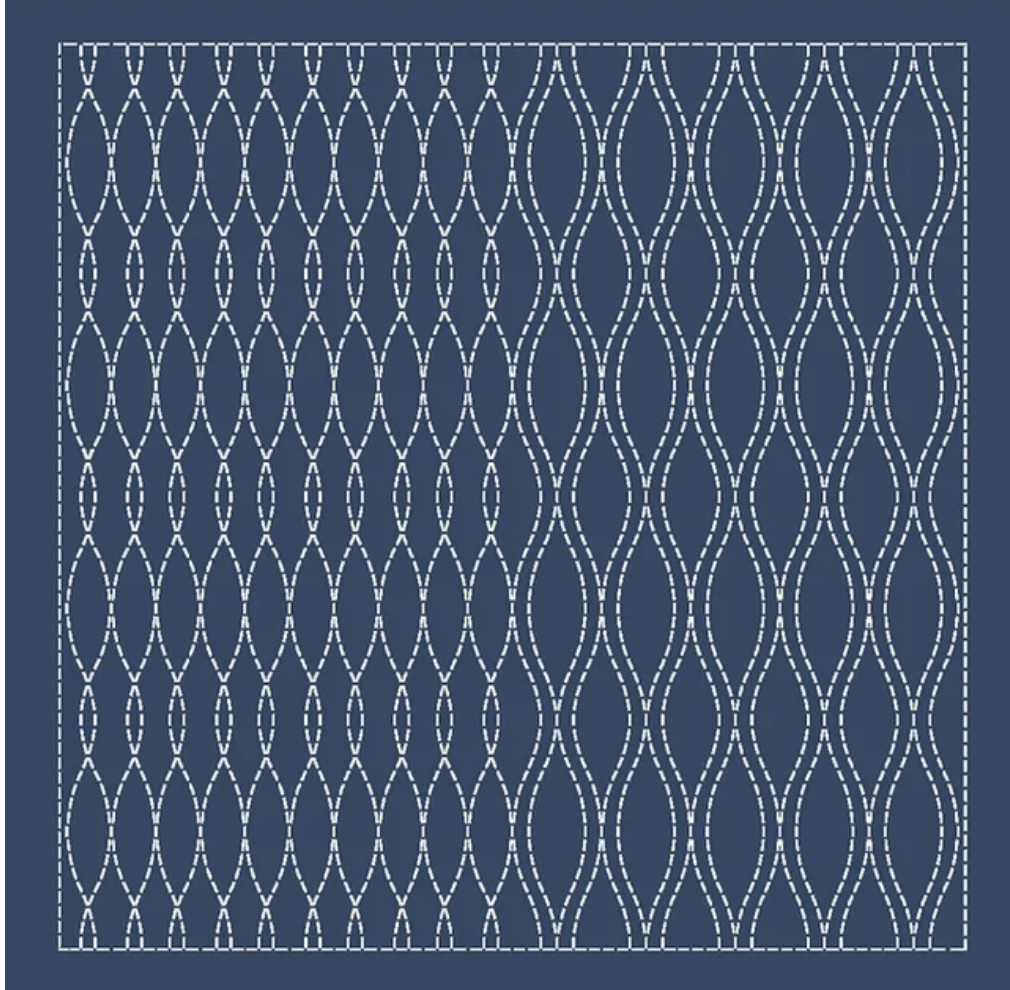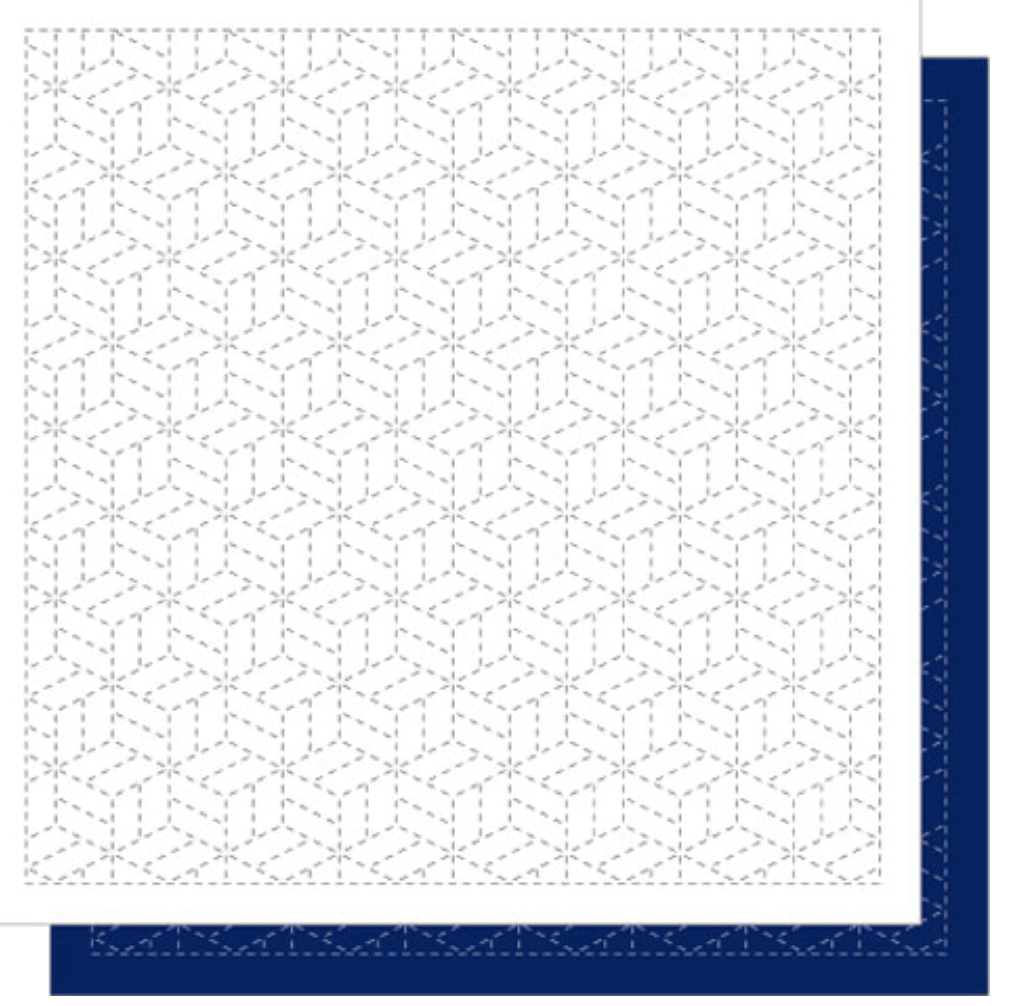Asagao (Morning Glory) Kugurizashi Sampler on Indigo Fabric
Create a stunning sampler of the Asagao (Morning Glory design with coloured sashiko threads. This sampler combines hitomezashi with kugurizashi (woven thread).
Hitomezashi (also called 'One-Stitch Sashiko') is a form of sashiko stitching which originated in rural Yamagata Prefecture in northern Japan. Hitomezashi patterns are designed on a grid system and stitched with a running stitch, except the intersecting stitches in hitomezashi touch each other whereas they don't in 'ordinary' sashiko.
Patterns in hitomezashi may look complicated, but they are reasonably easy to stitch as all you need to do is mark a grid of squares on your fabric and then you're good to go! Using a simple running stitch, work across the fabric horizontally from one side to the other. Stitch all the horizontal lines first, then repeat for the vertical lines, then stitch any diagonal lines to complete the design.
Hitomezashi usually takes more thread than 'ordinary' sashiko but the result is a strong, plump fabric with a complex-looking design.
Kugurizashi means 'go through' and is done after the main hitomezashi stitching. It is much easier than it looks, as you simply 'weave' the thread between the stitching and the fabric to create lovely patterns.
Our samplers are approximately 33cm x 33cm and include a plain fabric which can either be saved use as a backing, or you can stitch it double-layered, it's up to you. Stitching double-layered gives a nice, bouncy feel to the fabric but is slightly trickier in that you have to hide your starting and finishing knots by 'popping' them through the top layer. Sometimes the back of hitomezashi work looks really interesting in its own right, so this is definitely something worth trying.
Please note: you will need 6 skeins of 20m thread to complete this sampler - 2 for the hitomezashi and 4 for the kugurizashi.
Create a stunning sampler of the Asagao (Morning Glory design with coloured sashiko threads. This sampler combines hitomezashi with kugurizashi (woven thread).
Hitomezashi (also called 'One-Stitch Sashiko') is a form of sashiko stitching which originated in rural Yamagata Prefecture in northern Japan. Hitomezashi patterns are designed on a grid system and stitched with a running stitch, except the intersecting stitches in hitomezashi touch each other whereas they don't in 'ordinary' sashiko.
Patterns in hitomezashi may look complicated, but they are reasonably easy to stitch as all you need to do is mark a grid of squares on your fabric and then you're good to go! Using a simple running stitch, work across the fabric horizontally from one side to the other. Stitch all the horizontal lines first, then repeat for the vertical lines, then stitch any diagonal lines to complete the design.
Hitomezashi usually takes more thread than 'ordinary' sashiko but the result is a strong, plump fabric with a complex-looking design.
Kugurizashi means 'go through' and is done after the main hitomezashi stitching. It is much easier than it looks, as you simply 'weave' the thread between the stitching and the fabric to create lovely patterns.
Our samplers are approximately 33cm x 33cm and include a plain fabric which can either be saved use as a backing, or you can stitch it double-layered, it's up to you. Stitching double-layered gives a nice, bouncy feel to the fabric but is slightly trickier in that you have to hide your starting and finishing knots by 'popping' them through the top layer. Sometimes the back of hitomezashi work looks really interesting in its own right, so this is definitely something worth trying.
Please note: you will need 6 skeins of 20m thread to complete this sampler - 2 for the hitomezashi and 4 for the kugurizashi.
Create a stunning sampler of the Asagao (Morning Glory design with coloured sashiko threads. This sampler combines hitomezashi with kugurizashi (woven thread).
Hitomezashi (also called 'One-Stitch Sashiko') is a form of sashiko stitching which originated in rural Yamagata Prefecture in northern Japan. Hitomezashi patterns are designed on a grid system and stitched with a running stitch, except the intersecting stitches in hitomezashi touch each other whereas they don't in 'ordinary' sashiko.
Patterns in hitomezashi may look complicated, but they are reasonably easy to stitch as all you need to do is mark a grid of squares on your fabric and then you're good to go! Using a simple running stitch, work across the fabric horizontally from one side to the other. Stitch all the horizontal lines first, then repeat for the vertical lines, then stitch any diagonal lines to complete the design.
Hitomezashi usually takes more thread than 'ordinary' sashiko but the result is a strong, plump fabric with a complex-looking design.
Kugurizashi means 'go through' and is done after the main hitomezashi stitching. It is much easier than it looks, as you simply 'weave' the thread between the stitching and the fabric to create lovely patterns.
Our samplers are approximately 33cm x 33cm and include a plain fabric which can either be saved use as a backing, or you can stitch it double-layered, it's up to you. Stitching double-layered gives a nice, bouncy feel to the fabric but is slightly trickier in that you have to hide your starting and finishing knots by 'popping' them through the top layer. Sometimes the back of hitomezashi work looks really interesting in its own right, so this is definitely something worth trying.
Please note: you will need 6 skeins of 20m thread to complete this sampler - 2 for the hitomezashi and 4 for the kugurizashi.








